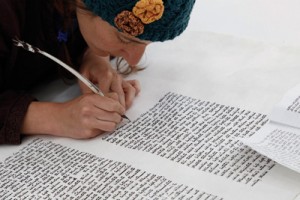Arts
Exhibit
Brief Reviews: Museum Happening As It Is Written: Project 304,805

It’s a mitzva to write a Sefer Torah.
In fact, the biblical commandment requires every Jew to write one, though this has been subject to interpretation and modification. For instance, one could participate in creating a Torah by proofreading one, or by donating funds. But historically, women were not allowed to study sofrut (Jewish scribal arts).
Times, obviously, have changed. Today, women, too, can write a Sefer Torah, though only a few choose to.
Among the new group of female scribes is petite, pigtailed Julie Seltzer, looking younger than her 34 years, who is not only writing a Sefer Torah but doing so in public, in the second-floor galleries of San Francisco’s Contemporary Jewish Museum (415-655-7800; www.thecjm.org). The exhibit—called “As It Is Written: Project 304,805” (for the number of letters in the Torah)—also includes abundant information about the significance of the Torah scroll in Jewish life, the rules governing its production and artifacts associated with it, such as cases, pointers, finials and Arks. There is also a gilded and carved 19th-century Indian Ark on loan from the Judah L. Magnes Museum in Berkeley. An old, no-longer-in-use Torah is also on display. Opportunities for viewer participation include interactive exhibits and a call for submission of bar/bat mitzva photos showing the Torah. In addition, 54 works by contemporary artists, each based on one of the year’s 54 Torah portions, are being collected and exhibited.
Soferet (female for sofer, or scribe) Seltzer—born near Philadelphia, educated at Brown University in Providence, Rhode island, and with a background in theater—has been learning Torah for most of her life. She became interested in sofrut through her love of the text and of Hebrew letters. With Orthodox Torah scribing schools closed to women—Conservative and Reform Judaism offer no scribing schools—Seltzer began learning to write the Hebrew letters with help from some Internet sites and later studied in New York with Jen Taylor Friedman, the first known woman to have completed a Sefer Torah. For her work on this Torah, which will take a year—the exhibit will continue through fall 2010—Seltzer was willing to relocate to the Bay Area for the duration. This will be her first completed Torah.
Seltzer scribes for several hours a day, but no more than an hour or so at a time. Twice a day, at set times, she takes questions from viewers. Among the most frequent questions—and the most common misconception—is what to do about mistakes. No, she explains, a scribe doesn’t have to start all over if he or she makes a mistake, but the process of correcting one is complex and time-consuming: the dried ink must be scraped off with a blade, then erased with an architectural eraser, after which chalk is used to cover any residual color.
Many rules govern the production of a Sefer Torah and the work of a scribe. The Torah is written on 62 sheets of parchment, made from the treated skin of a kosher animal. (No animal may be slaughtered just to produce a Torah.) The skin is soaked in water, then in limewater, then stretched and pressed. It is scored with 43 horizontal and two vertical lines per column of text, with four columns per sheet. The ink must be black and made of mostly gallnuts and azurite powder. The quill is from a kosher bird. Nothing made of metal may be used, as metal is associated with warfare.
Each letter must be written according to a set order of strokes and separated from other letters by blank parchment, with no letters touching each other or the edge of the parchment. Words must also be separated. No barrier between hand and parchment, such as a glove, is permitted. On completion, the individual sheets are sewn together with the sinew of a kosher animal.
A Torah is not signed; each Torah is unique because it is written by a different individual and yet identical in content and appearance to every other Torah written during the past four centuries.
Once completed, the Torah must be proofread. “Anybody who knows Hebrew can proofread—it’s considered a mitzva,” says Seltzer. In a nod to modern times, a final reading is done by a computer. The completed Torah will be given to an emerging or in-need Jewish congregation.
Museum Director Connie Wolf says she got the idea for the exhibit from a conversation with Arnold Eisen, chancellor of New York’s Jewish Theological Seminary. “If you want something Jewish, there’s nothing like a Torah,” he said. The show, which began last October 8, 2009, and ends October 3, 2010, has been a hit: On one free-admission day, some 3,700 people attended—about half, Wolf judges, non-Jewish.
Seltzer works behind a desk, surrounded by her materials—ink, a quill made from a wild turkey feather (which necessitates sharpening about every five lines), a photocopied Torah to copy from, as writing from memory is not permitted. As prescribed, she speaks each word before writing it. Visitors can watch Seltzer’s progress on a live video feed.
“I got into this through the love of Torah, the love of the letters,” the soferet says. “I feel really blessed that I can do this.”
In response to a visitor’s question about whether she has mystical feelings while writing, Seltzer says, “I don’t experience any floating, glowing letters—yet. But I’m open….










 Facebook
Facebook Instagram
Instagram Twitter
Twitter
Leave a Reply